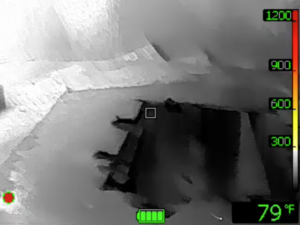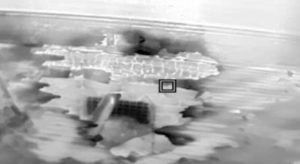This is a common question asked but has many variables that influence the answer.
First-It depends on the background:
If the background temperature is similar to the floor, the area of the hole may blend in with the existing image due to a lack of contrast. Whereas if the floor and the area underneath are different temperature the hole may be visible through the TIC.
If we have a high resolution TIC and stay in High Sensitivity by staying low in lower temperatures we can SEE Better. This is demonstrated by the following image below. The TIC is in high sensitivity which allows for better detail and image clarity at lower temperatures. There is also a notable temperature difference in the floor below.

If the area underneath and the floor are similar temperatures it can be very hard to discern or see it all as shown in the following photo.

However, we can create contrast by flowing water across the floor and waiting a few seconds before we move. The water will pool in areas of depressed or damaged areas of floors creating a cavity effect.
Second-It depends on if there is heat coming from underneath:
If we see convection currents coming straight up from the floor and moving laterally towards the ventilation point we can identify it by seeing the chimney effect coming from below us.
Some notes of caution:
When performing VES, one can scan a room and “SEE” not much heat even though there is significant heat coming through the doorway from the fire towards us. If the fire is below us and the room we are about to enter has not been heated up by those convection currents, the TIC will read the surface temperatures as normal or low.
One should quickly identify the doorway, areas of heat transfer through floor registers or ceiling vents (as shown in the third photo), and look for signs of thermal bridging from adjacent rooms to identify concerns. We have also seen the TIC switch into low sensitivity when being pointed at the floor with no visible signs of heat transfer. This is also a red flag of heat transfer in this area.
In all areas fire service related, context matters the most! Always consider the building construction, it’s actual condition (prior to the fire) and level of severity. A mobile homes floor will show heat transfer much easier than a built up floor in a standard platform construction home with two layers of flooring and an insulated layer underneath it.
As always, a TIC doesn’t replace a well trained firefighter but it can be a force multiplier for those who know, understand, and use it appropriately.
Stay Intelligently Aggressive.
Instructor Andrew Starnes
Insight Training LLC
Level II Thermography Certified
